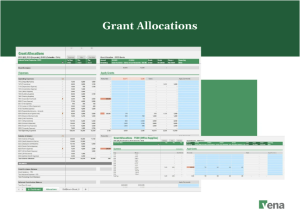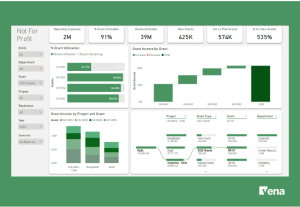Managing a nonprofit’s finances can sometimes feel like captaining a ship where the crew spends more time mapping the journey than actually sailing. Nonprofits often find their primary mission sidelined because key personnel are bogged down with reporting every penny, often using cumbersome Excel spreadsheets.
While this meticulous tracking is essential for regulatory and fundraising purposes, automating these processes can free up valuable time for your team to focus on the organisation’s core mission.
In this blog, we’ll explore the importance of detailed financial reporting for charities and nonprofits, the types of financial statements they need, country-specific reporting regulations, and how Vena can streamline nonprofit financial planning.
We’ll highlight key nonprofit financial reports, and what they should include, and even provide an Excel template to streamline your reporting efforts.
Why Charities and Nonprofits Need Detailed Financial Reporting
Charities receive both unrestricted and restricted funds. Restricted funds come with pre-determined rules on how they can be used and are highly regulated. Given this complexity, it’s crucial for nonprofits to maintain detailed and transparent reporting to ensure the judicious use of funds.
There are three main reasons for this:
- Future Fundraising and Building Donor Trust
Nonprofits need detailed, reliable, and up-to-date financial reports to apply for funding. Major funders review financial track records and spending patterns before committing support. Individual donors also feel more confident contributing when they can track where their money goes. In fact, give.org’s Donor Trust Report states that 64% of all donors say trust in a charity is extremely important, yet only 20% report having a high level of trust in nonprofits. However, many charities rely on manual, Excel-based processes that aren’t equipped for detailed reporting, leading to accountability gaps. - Legal and Regulatory Compliance
In most states, charities must maintain accurate financial records to attain nonprofit status. Payroll, donations, and expenditures are regularly monitored to ensure money isn’t being misused. For example, the Internal Revenue service (IRS) requires that an organisation’s purpose aligns with Section 501(c)(3) of the Internal Revenue Code for its donations to be tax-deductible. - Strategic Resource Allocation
Detailed financial reports help nonprofits assess cash shortages and plan how to fund projects and raise additional funds. For example, before using Vena, WWF Canada’s finance team spent more time distributing data manually than analysing it. “Everyone was managing their program plans with different templates, so rolling that up into a final budget was a big task,” said Clement Marlin, WWF Canada’s Senior Financial Specialist. “If things changed, we couldn’t revisit them in a timely fashion.”
5 Types of Financial Reports Every Nonprofit Needs
- Donor Reports
Donor reports combine data on beneficiaries and funds with testimonials and case studies. They include critical information such as funding, expenditure breakdowns, impact metrics, and funding allocation, and are often used as marketing and fundraising collateral. - Grantor Reports
Grantor reports communicate how funds are meeting grant stipulations. They include grant allocations, utilisations, expenditure breakdowns, project results, proposed vs. actual budgets, and future financial goals. These reports are detailed and comply with specific requirements.

An example of grant allocation reports created in Vena

An example of a grant utilisation report created in Vena

An example of a variance report by project created with Vena
- Audited Financial Statements
Nonprofits need audited financial statements, including the balance sheet, income statement, statement of cash flows, and a statement of functional expenses. These are audited by independent accountants for accuracy and compliance with generally accepted accounting principles (GAAP). - Board Reports
Nonprofit board members require financial reports tailored to the organisation’s governance. These include budget vs. actual reports, cash flow forecasts, and specific program or project financial reports, enabling board members to oversee the nonprofit’s financial health and strategic direction. - State Filings
In the US, most states require nonprofit corporations to file one or more reports or registrations annually. These can include corporate filings, financial reports, fundraising registrations, and state tax-exemption filings. The specific requirements vary by state, so maintaining detailed financial records is crucial.
Reporting Requirements for Nonprofits in the US, Canada, and UK
United States
According to the IRS, nonprofits must produce four financial reports:
- Statement of financial position: Shows the organisation’s assets, liabilities, and net assets at a specific time.
- Statement of activities: Details revenues, operating expenses, and changes in net assets over a specific period.

Examples of granular operating expense reports created in Vena, allowing you to report on expenses by function.
- Statement of functional expenses: Breaks down expenses by function: program services, management, and fundraising.
- Statement of cash flow: Categorises cash movements into operating, investing, and financing activities.
Canada
The Government of Canada requires financial statements to include:
- Statement of assets and liabilities (balance sheet)
- Statement of revenue and expenditures (income statement)
- Prepared notes on accounting policies, investment details, revenue sources, non-arm’s length transactions, donor-directed funds, and future obligations.
United Kingdom
All charities must keep accounting records for at least 6 years. Charitable companies, governed by both company and charity law, must maintain detailed records for Gift Aid payments and substantial donors. Only charities with gross income over £25,000 need independent examination or auditing, except for NHS charities.
Examples of Nonprofit Financial Reports
World Wildlife Fund
WWF provides both an annual report and a financial audit report. These reports start with the four financial statements required by the US government and end with notes on accounting policies. You can find their reports here.
Doctors Without Borders (Medecins Sans Frontieres)
MSF’s financial report includes programs, activities, financial statements, treasurer’s reports, and auditor’s reports, illustrated with infographics, graphs, and charts. Read the full report here.
Feeding America
Feeding America’s auditor report includes all four financial statements and notes. Their webpage also features a gratitude report, a subset of the donor’s report. Read the full report here.
How To Automate Your Nonprofit Financial Reporting With Vena
Vena for Not-for-Profit provides the granularity needed to meet grantor and government reporting requirements, allowing you to easily manage restricted and unrestricted funds. Vena’s pre-configured solution for nonprofits includes:
- Fund Reporting: Audit-friendly reports on grant status.
- Scenario Modeling and Cash Flow Planning: Projects funding based on grant arrival.
- ERP Integration: Streamlined financial planning, even with specialty systems like Blackbaud.
- Grant Management, Planning, and Budgeting: Tracks and reports on grants, reconciling budgets with grant timings.
- Grant Allocation Planning: Manages restricted and unrestricted funds efficiently.
- Intelligent Dashboards and AI-Powered Insights: Empowers your team to gain insights into donor behaviour and financial health.
Using Vena, your finance team can shift focus from manual accounting to optimising fundraising and operations, helping you achieve your nonprofit’s core mission more effectively.

An example of a Vena Insights dashboard tailored to support nonprofits in tracking their most important metrics like grant income and utilisation at a glance.
*Content provided by vena.com
